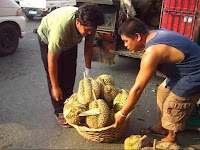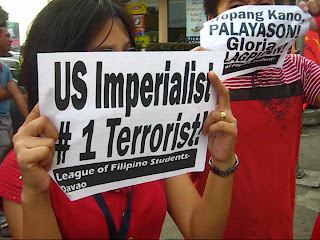Our Media Law professor Mukund said this was not what he saw when he observed the press in the Philippines. Submitted as a paper in the Media Law class we took with the rest of the ACFJ fellows batch 2008 in the first semester of SY 2008-2009:
If media culture in the Philippines is plagued with ideological bias, it is not yet the “liberal left” bias that
Marlin Maddoux talked about in the book chapter,” Free Press or Propaganda? How the Media Distort the Truth,” but more on what Noam Chomsky said about the corporate media’s hunger for profit that media oftentimes become an unwitting tool of those in power to “manufacture” the consent of the public.
In fact, one only has to watch five minutes of prime time TV in the Philippines and see how one gets bombarded by the conventional, subtly masochistic and sadly (some remnants of) colonial worldview.
The media oftentimes take the standpoint of powerful institutions (corporate, government and otherwise) and wittingly or unwittingly package this as unquestioned Truths.
That’s why, I consider it a good thing when liberal-left ideas, such as the concept of press freedom and media independence, creep into the consciousness of the mainstream press.
I say “creep in” because these liberal-left ideas have never been so “esconced” in the mainstream press despite the Philippines’ long tradition of press freedom.
The country’s tradition of press freedom that dated back to its struggle against its former colonizers over a century ago, only asserts and reasserts itself, depending on the political situation in the country.
For a long time, it has been considered a “given,” that the Philippine media is considered the “freest in Asia.” And yet, it has not been able to use this press freedom (coupled by advances in technology) to keep its citizens well-informed.
Most often, the media in the Philippines have become spokespersons and mouthpiece of those in power.
In between the country’s past, when it was not under the grip of a political turmoil that marked the time of the dictatorship of former President Marcos and now during the time of President Arroyo, the media as an institution was in a lull, driven by the ideology of market forces.
For instance, the left liberal idea of press freedom was very strong during the struggle against the dictatorship of Marcos in the 1970s and the 1980s, but rather weak during the market-oriented policies espoused by former President Ramos.
During the time of Ramos, the media (except for the few alternative presses) had carried the government’s standpoint hook, line and sinker on such policies as deregulation, privatization and the country’s supposed role and participation in the global free trade era.
There have never been in-depth reports coming from the mainstream media during the time of Ramos that challenged this government line. Except for those coming from few alternative presses, of course, most of the reports never questioned policies on deregulation, the privatization and even the country’s prospects in the liberalized trade era under the World Trade Organization (WTO).
It was a pity that the media at this time only mouthed what the government was saying. Yet, the impact of what was never discussed before is now staring us in the face.
For instance, the government’s classical WTO line during the time of Ramos was, the Philippines should only produce goods that the country has a ‘comparative advantage,” compared to other countries.
Both the country’s top industry players and government trade officials were saying that the country should only produce goods which local producers can produce fast and cheap and in better quality than those in other countries so that they can compete in the world market.
In other words, they were saying that the country should not bother producing goods which take much longer time--and more costly--to produce.
The Philippines would rather import those goods from other countries, which can produce them cheaper.
The country’s rice problem had sprung from this policy, which the media failed to check at the earliest stage of its inception.
Because of this policy of importing “cheap” rice, the government neglected its own agriculture. The country has become so dependent on other countries for the supply of this critical staple food, increasing the country’s vulnerability to price fluctuation in the world market and in the end, threatening the country’s food security.
This is an example how media’s bias for the powerful policy makers, trade and industry players has undermined its prime and important obligation of informing the public.
The Bill of Rights, Section 7 of the Philippine Constitution provides for the public’s right to know, by recognizing the “right of the people to information on matters of public concern.”
However, this provision in the Constitution is oftentimes set aside and forgotten in the day to day operations of the media. It’s only very rarely that citizens invoke this Constitutional provision to assert their right.
Government has also come up with policies and statutes that seek to block transparency of public records; like the Executive Order 464 that bar Cabinet and other government officials from testifying in Congress without the President’s consent.
Invoking national security issues, the government also came up with the Human Security Act, which also restricts media’s role in informing the public. Under this law, the media interviewing terrorist suspects can also be held liable and guilty of “acts of terrorism.”
At present, the Freedom for Information Act, which will require government offices to make available public documents in a matter of days, is still pending in Congress.
But the rise of institutions in the country fighting for press freedom, media independence and ethical practice, has ensured that the media become conscious of its role not only as watchdog, but also as an institution that can give voice to the voiceless in society.
Slowly, it has dawned upon most of the media practitioners to uphold their independence and police their ranks for abuses, rather than relegate this duty to some interest groups and powers-that-be who might subject the media to their own agenda.
In the Philippines, however, what has been denied from the people by the elitist Philippine media always finds expressions in political cartoons, which is the easiest and most accessible reading fare among the masses.
For instance, more people savor the biting humor of “Pugad Baboy” which expresses wry commentary about the political situation in the country in the most humorous way.
I don’t think that these political cartoons are “less biting” than those in other countries. They reflect Filipino humor and the country’s political situation that the masses can easily identify.
Despite of and amidst of the killing of journalists in the country, I can say that the political cartoons—dating from the time of Marcos to the Hello Garci tapes under Arroyo and onwards--are biting critiques of today’s Philippine society.
But it’s a different story altogether for television sitcoms.
In the Philippines, it’s very rare for television sitcoms to push the liberal left agenda. In fact, television sitcoms are still tainted with conventional, machosist bias and conservative standpoint.
The dominant network culture, as Noam Chomsky said, is market driven and is influenced by both corporate advertisers and top policy makers in government.
Despite its relative political freedom, though, the media in the Philippines do not, as a general rule, make outright fun of religious conservatives. As a rule, majority of media practitioners grew up and are still part of the predominant Catholic culture, hence, the subconscious reluctance to displease someone with so-called religious authority.
In fact, the marrying of corporate interest with that of the predominant conservative culture have their expression during Christmas season, when everything from soap operas to variety shows and public affairs programs tend to encourage buying spree for supposedly “gift giving” among the public, even amidst the increasing poverty and declining purchasing power of the Filipinos.
In this example, I understand what Maddoux was saying about the media using “repetition,” “selective reporting” and the “conscious dispensing with perspective” to promote the ideology of the market.
 Maybe, she's still out there, doing volunteer works in Kerala. Though, I found out a few days ago the Kerala she was talking about is not the place where Arundhati Roy grew up but quite a totally different kind of Kerala.
Maybe, she's still out there, doing volunteer works in Kerala. Though, I found out a few days ago the Kerala she was talking about is not the place where Arundhati Roy grew up but quite a totally different kind of Kerala. 














.jpg)
.jpg)




















